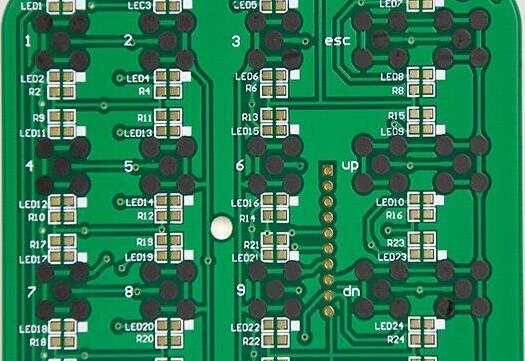Carbon ink PCB board refers to a PCB board that is coated with carbon conductive ink (abbreviated as carbon ink) on the substrate of the PCB board and solidified to form a carbon film conductive pattern. The production cost of PCB boards requires a continuous reduction, and the trend is to replace the expensive gold buttons with carbon ink buttons. Carbon ink buttons have strong wear resistance and can withstand multiple repeated operations, typically reaching a normal opening and closing effect of 100,000 or even millions of times.

Carbon serves as a conductor to connect two lines on a PCB board and acts as a resistor between the lines or components. The key factors in the production of carbon ink PCB are controlling printing, baking, and resistance control. This carbon oil can be printed on flexible circuits, rigid-flexible boards, and rigid PCBs, such as polyamide, polyester, FR-4, FR-5, and PTFE laminates. Carbon ink can provide line width and distance up to 100 μ The resolution of m.
The carbon ink plate adopts a carbon slurry filling process, which evenly distributes carbon particles in thermoplastic resin to make conductive ink, and then covers it with green bridge oil to make it. It has high toughness, thin thickness, good insulation, and a lower price than gold plating. It is commonly used in high-voltage, pulse, and high-frequency circuits.
Factors affecting the production quality of carbon ink PCB
1. Graphic Design
The production of conductive carbon ink PCB adopts the additive process, and the insulation inner layer and conductive coating are made using the screen printing method. The connecting disks are stacked to achieve the connection effect of connecting the upper and lower layers of the circuit. In this way, its production only needs to add two layers of printed graphics on top of the production process of a single-sided circuit board.
2. Selection of Screen Printing Materials
1) Selection of conductive carbon ink for insulation isolation layer
The insulation isolation layer is a printed layer that supports and insulates jumper wires. The quality of this layer directly reflects the quality of the product. The selection principle of the insulation layer ink is to have high insulation. Therefore, the insulation layer ink of the phenolic system is generally chosen.
2) Selection of Carbon Conductive Ink
Carbon-based conductive ink has a lower surface contact resistance and exhibits good conductivity: a smaller coefficient of friction, which can be increased with more friction times.
Carbon ink, choose carbon ink as the main component. The shape of carbon ink particles is similar to spherical colloidal particles. Graphitized carbon ink has a high carbon content, extremely low resistivity, high conductivity, and a large surface area for separation, resulting in strong adsorption. Due to its small particles, its dispersion increases, resulting in reduced resistance, extremely high conductivity, increased variable area, and enhanced wear resistance.
3. Control of the production process
In terms of production process control, the main points to be noted are as follows
Control of screen printing process methods
screen printing plate
The effect of curing conditions on resistance
The impact of the punching process
The influence of the surface treatment process
Carbon ink PCB is a material made of high-purity graphite sintered at high temperatures, with very high strength and hardness. Compared with metal materials, carbon plates have higher strength and advantages in high-temperature and high-pressure environments.